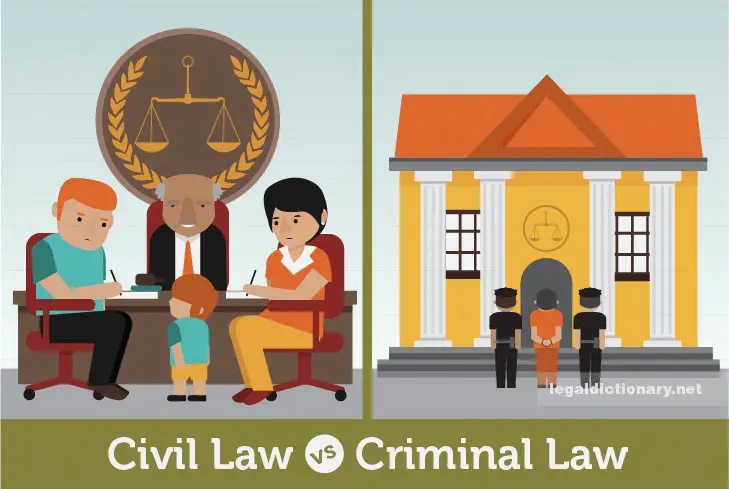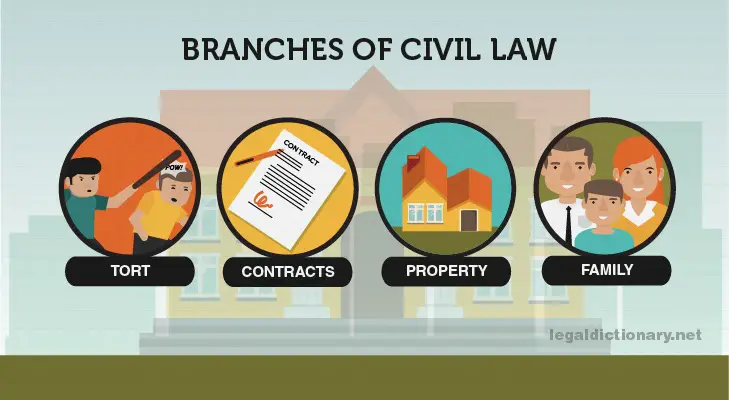Civil Law
Civil law is a body of rules that defines and protects the private rights of citizens, offers legal remedies that may be sought in a dispute, and covers areas of law such as contracts, torts, property and family law. Civil law is derived from the laws of ancient Rome which used doctrines to develop a code that determined how legal issues would be decided. To explore this concept, consider the following civil law definition.
Definition of Civil Law
- Noun. The body of laws that govern ordinary private matters, separate from laws presiding over criminal, military, or political matters.
- Noun. The body of law that governs private or civil rights, providing redress for wrongs by compensating the person or entity that has been wronged rather than punishing the wrongdoer.
Origin: Late circa 1400 Late Middle English jus cilile
What is Civil Law
Emperor Justinian I ruled ancient Rome from 527 A.D. to 565 A.D. One of his lasting legacies is his rewriting of Roman law in “Corpus Juris Civilis,” (“Body of Civil Law”) which still serves as a basis for modern civil law systems worldwide.
In the United States, civil law has a couple of different meanings. In most parts of the U.S., civil law is synonymous with “common law,” or “judge-made law” which relies on prior court decisions to determine the outcome of cases. The governing principle is “Stare Decisis,” which means that the outcome of a lawsuit depends on the outcomes of previous similar cases.
Civil Law vs. Criminal Law
Civil law and criminal law serve different purposes in the United States legal system. The primary purpose of civil law is to resolve disputes and provide compensation for someone injured by someone else’s acts or behavior. The primary purpose of criminal law is to prevent undesirable behavior and punish those who commit an act deemed undesirable by society.
In civil law, it is the injured person who brings the lawsuit. By contrast, in criminal law, it is the government that files charges. The injured person may file a complaint, but it is the government that decides whether criminal charges should be filed. A violation of criminal law is considered a crime against the state or federal government and is a violation of public law rather than private law. Civil law cases are concerned only with private law. In some instances, a person may be entitled to file a complaint, trusting the legal system to punish the wrongdoer with prosecution, while bringing a civil lawsuit to receive compensation for the damages done by the wrongdoer.
Another key difference between civil and criminal law is the standards of proof required to reach a verdict. A plaintiff need only prove his civil law case by a “preponderance of evidence.” This standard requires that the plaintiff convince the court that, based on the evidence presented at trial, it is “more likely than not” that the plaintiff’s allegation is true.
In contrast, the standard of proof is higher in criminal law proceedings. The state must prove their case “beyond a reasonable doubt.” The reason for this higher standard is because a person’s freedom is at stake, and the fundamental belief that convicting an innocent person is worse than allowing a guilty person to go free.
Branches of Civil Law
Civil law cases are divided into four main categories, each covering a range of issues. See below for the types of civil cases and corresponding civil law examples.
Contract Law
Contract law deals with agreements between two or more parties, each of which is obligated to hold up their portion of the agreement. For example, two parties enter into an agreement for the lease of an apartment. The Lessor has the right to use the apartment, and the landlord receives rent money as compensation. If one party violates any of the provisions of the contract, they have committed a civil wrong known as “breach of contract.” Generally speaking, contracts may be oral or written, however there are certain types of contracts that must be put in writing.
Tort Law
Tort law is a branch of civil law that is concerned with personal injury and civil wrongdoing. A tort is a civil wrong, done by one person or entity to another which results in injury or property damage, and frequently involves monetary compensation to the injured party. There are three categories of torts: negligence, intentional tort, and strict liability.
Negligence is an unintentional tort, to which there are four elements that must be satisfied.
- Duty. The defendant had a duty to act in a reasonable manner
- Breach of Duty, meaning that the defendant failed to act reasonably
- Causation. The defendant’s breach of duty must be the cause of the plaintiff’s injury or loss
- Damages. Monetary, property, or other loss
An intentional tort is a deliberate wrongdoing in which the defendant acted with intent to cause harm or injury. Some examples of intentional torts include: assault and battery, false imprisonment, fraud, invasion of privacy, and intentional infliction of emotional distress.
Strict liability is a tort that does not require actual negligence or intent to injure. It is based on an absolute or “strict” duty to ensure something is safe. Strict liability frequently comes into play with hazardous activities, such as bungee jumping. The company that owns the bungee cords, or offers the activity to consumers, has an absolute duty to make sure the bungee cords are intact, hooked up correctly, and are ready to operate safely. If a consumer is injured because the cord breaks or comes undone, the company is liable for the injury under strict liability.
Property Law
Property law covers both personal property and real property. Personal property can be tangible, such as jewelry, animals, and merchandise, or intangible such as patents, copyrights, stocks, and bonds. Real property refers to land and anything built on it that cannot be easily removed, as well as anything under the surface of the land, such as oil and minerals. There are two types of property law torts: trespass and conversion.
- Trespass to chattels refers to a defendant intentionally and physically interfering with the plaintiff’s right to possession and use of their personal property.
- Trespass to land occurs when a defendant enters plaintiff’s private property without consent of the plaintiff.
- Conversion refers to a defendant depriving a plaintiff of their personal property without the plaintiff’s consent, and then using the plaintiff’s property as his own.
For example, a lady sees her neighbor planting flowers in her garden, and notices she has five extra containers of flowers with no place to plant them. The lady decides she would like flowers in her garden as well, and takes the leftover containers of flowers without asking for permission from neighbor. The lady deprived the neighbor of her flowers, planting them instead in her own garden. The lady has committed conversion.
Family Law
Family law is the branch of civil law that deals with marriage, divorce, annulment, child custody, adoption, birth, child support, and any other issues affecting families. This branch of civil law is unique in that there is not necessarily a person who committed a civil wrong. This is particularly true in states that have no-fault divorces. The family court gets involved with dividing up property and finances after a divorce, establishing child custody, child support, and spousal support among other things. Some newer areas that fall under the family law umbrella are same-sex marriage, artificial conception, surrogate motherhood, in vitro fertilization, and palimony.
Civil Case Example
While the lawsuit against McDonald’s made national headlines, the facts of the case regarding negligence, defective product, and breach of implied warranty make a fascinating civil case.
Liebeck v. McDonald’s Restaurants CV-93-02419, 1995 (N.M. Dist., Aug. 18, 1994)
This case began when 79-year-old Stella Liebeck, who was a passenger in her grandson’s car, purchased a cup of coffee at McDonald’s drive-through. While the car was still parked, Liebeck removed the lid from the cup to add some creamer to her coffee, inadvertently dropping the cup and spilling the scalding hot coffee on her lap. Liebeck suffered third-degree, deep tissue burns on her legs that required multiple surgeries and skin grafts.
Liebeck filed a civil lawsuit against McDonald’s for her injuries under the torts of strict liability and negligence. This case was controversial in that the media portrayed Liebeck’s civil lawsuit as frivolous because she was suing over coffee being too hot. However, the damages to her body, her pain and suffering, loss of income, and loss of enjoyment in life due to pain were real and she did prevail in court. The jury found that the defendant’s product (the coffee) was defective (too hot to drink) and this constituted a breach of implied warranty (the assumption that the coffee was safe to drink). The jury also found that Liebeck was twenty percent at fault for her injuries.
Related Terms
- Preponderance of Evidence – the standard of proof used in most civil trials; the jury is instructed to find for the party that has the stronger evidence, even if it is only marginally stronger than the other side.
- Beyond a Reasonable Doubt – the standard of proof used in criminal trials; a reasonable person would believe that the defendant is guilty of the crime; a higher standard than is used in civil law.
- Common Law – the body of law that is based on judicial decisions.
- Stare Decisis – the doctrine that requires judges to use prior cases as precedent on which to decide current cases.
- Case Law – judge-made law; law that is found in collections of reported cases.
- Chattels – an item of tangible, movable property; possessions that can be moved from one place to another.
- Lessor – a person who leases or rents out a property; a landlord.
- Lessee – a person to whom a lease is granted; a tenant or renter.


